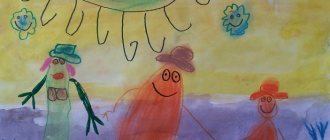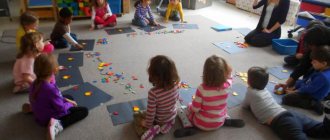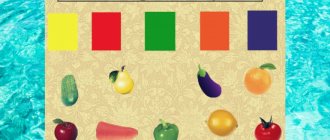Summary of the lesson on designing “Cheerful Man”
Lesson notes for first year groups
"Merry Man"
Target:
Distinguish between natural and artificial materials.
Tasks:
Educational:
- learn to name the properties of natural and artificial materials, be able to find the difference;
— teach children the rules of using materials and tools;
Educational:
- develop creative imagination, imaginative thinking, fine motor skills;
— develop the ability to evaluate and describe the result of one’s own creative work;
Educational:
— educate and teach children to respect nature;
— introduce children to observing safety precautions when working with piercing and cutting objects.
Expected Result:
They will know:
— properties of natural and artificial materials;
— safety rules when working with piercing and cutting objects.
Will be able to:
- be able to find the difference between natural and boron materials;
- evaluate and describe the result of your own creative work;
Materials and tools:
34 plastic lids of different colors, 5 plastic Kinder Surprise eggs, elastic band, scissors, awl, gypsy needle, plastic eyes, glue gun.
Progress of the lesson
| Name of the lesson stage | Activities of a teacher | Student activities |
| Organizational part | The teacher creates a favorable atmosphere for work in the classroom. Game "Hello, everyone!" Each child should shake hands with the children standing next to them. Attention is focused on the fact that you need to shake hands kindly, look into the person’s eyes and say your name. Teacher: Children, today we will visit a fairy tale. Close your eyes and count to ten. Here we are in a fairy tale. Funny people live here. Where are they? They want you to work hard and come up with them. Children are surprised, show interest, want to make little people from waste and natural materials | They play a game. Consider. Children are surprised, show interest, and want to make little people out of waste material. |
| Main part | Getting to know waste and natural materials. Children are invited to divide into groups, examine the materials, and talk about their properties. Leads children to conclusions about the properties of natural materials : has size, color, shape, smell, wrinkles, bends, tears, breaks. Working with illustrative material: task on drawings: carefully examine the pictures and determine which is natural and which is artificial material. conclusion. Artificial material was invented by man. Natural material is given to us by nature. You can make wonderful crafts from natural materials. Nature must be loved and protected | Complete the task. Complete the task. Children speak out and offer options. |
| Fizminutka | The teacher invites the students to stand in a circle and repeat the words and actions: I have such hands! Look! They clap their hands loudly, One, two, three! Your hands too, they look like mine It's good for you, my friend, Spin with me once! I have such legs! Look! I'll stomp a little, One, two, three! Your legs also look like mine, It's good for you, my friend, Spin with me once! I have such a back! Look! I'll pat you on the back, One, two, three! Your back is also similar to mine, It's good for you, my friend, Spin with me once! | Repeat the movements after the teacher. |
| Main part | Safety precautions . The teacher reminds the rules of working with piercing and cutting objects. | |
| Practical work | Children are invited to design little people from plastic corks. Children get to work accompanied by cheerful music. | Complete the task. |
| Fizminutka | Finger game "Funny men" Funny little people were running past the river (“little men” - fingers running along the “paths” - the hands of children standing opposite each other). They jumped and jumped with their fingers to “jump” on each other’s shoulders). We greeted the sun (gently put our hands on each other’s cheeks). We climbed onto the bridge (make the bridge with your hands). And they hammered in a nail (knock with fists). Then - splash into the river (bend over and shake your arms freely). Where are the little men? (hide your fingers under each other’s armpits). Girls and boys are friends in our group, And now Little Fingers will become friends. One, two, three, four, five - Let's start counting them. One, two, three, four, five - Let's start counting them! | They play a game. |
| Reflection | Did you like working with natural materials? What difficulties did you experience during the lesson? Tell us about your craft. | Answer questions. They talk about their craft - what they called it, what materials it was made from, how they will use it. |
| The final part. | Invites children to choose the neatest craft. | Choose a craft. Analyze and express their opinion. |
Master class “Jolly little man”
1. Make a hole in the center of each lid using an awl.
2. Prepare a long piece of elastic and insert a gypsy needle.
3. Thread the plastic egg onto the edge of the elastic and secure with a knot.
4. Form a human leg by stringing 8 caps, then set it aside.
5.
Make the second leg in the same way.
6. Make 2 holes in the larger lid and attach the legs to it.
7. String 2 caps on the body, a plastic egg, a cap on the neck, an egg as a head and 2 caps on top.
8. Secure the structure with a tight knot.
9. Tie a piece of elastic around your neck as arms.
10. String 6 caps and a plastic egg. then secure with a knot.
11. Weave the other arm in the same way.
12.
Glue on the plastic eyes.
GCD summary. TOPIC: “FIXIK VISITING PRESCHOOL CHILDREN.” (construction from Lego)
Educational activities of an artistic and aesthetic orientation made from Lego develop technical thinking in preschoolers, and joint work with parents contributes to the development of social and communicative development. Topic: “Fixie visiting preschoolers.”
Age group: senior.
Goal: development of technical thinking in children.
Integration of educational areas: “Artistic and aesthetic development”, “Socio-communicative development”, “Cognitive development”, “ Speech development”, “Physical development”.
Tasks:
- Form the development of prerequisites for creating a transport model according to the scheme, the perception of music. (Artistic and aesthetic development).
- Develop cognitive activity through constructive activities with the help of new generation construction sets. ("Cognitive Development")
- Enrich and activate your vocabulary. Improve the dialogical form of speech, the ability to formulate your point of view (Speech development).
- Form the development of prerequisites for creating a transport model according to the scheme, the perception of music. (Artistic and aesthetic development).
- Develop the ability to work in pairs with adults, distribute responsibilities without interfering with each other. (Socio-communicative development).
- Develop children's motor activity and coordination of movements (Physical development).
Preliminary work: Observation of transport during a walk, transport on which food is brought to kindergarten, conversations, games with cars, and construction sets.
Methods and techniques:
- practical: Lego construction sets, finger gymnastics;
- visual: diagrams, balloon, Fixik toy, box;
- verbal: direct questions, leading questions, explanations, riddles, reading a poem;
- playroom: Lego construction sets,
Materials and equipment: a balloon, a Fixik toy, a box with a Lego constructor, riddles about transport, a player, a flash drive.
| Children's activities | Forms and methods of organizing joint activities |
| Cognitive and research | Naming helper objects. |
| Communicative | Conversation, guessing riddles, situational conversation, questions |
| Perception (fiction and folklore) | Telling riddles, reading a poem |
| Motor | Finger gymnastics, |
| Musical | The sound of musical works |
Logic of educational activities
| № | Activities of the teacher | Activities of pupils and parents | Expected results |
| 1. | Organizing time. - Everyone gathered together in a circle. You are my friend and I am your friend. Let's hold hands tightly and smile at each other. - Dear, good, how are you doing? Today design has come to visit you. (knock on the door) | Children and parents stand in a circle, hold hands, smile, and answer the question. | A positive emotional mood for educational activities has been created. Friendly relationships between peers and parents. The ability to perform movements according to the text is consolidated. |
| - Is someone knocking? May I take a look? (goes to the door, brings in a balloon with Fixie). | They look at the door with interest, wait, smile, rejoice at Fixik’s appearance. | Voluntary attention is attracted. | |
| 2. | "The Appearance of Fixik" (teacher on behalf of Fixik) – Hello dear parents and you children: girls and boys! Please name the topic of the week? What types of products are there? Where can you buy groceries? What happens when stores run out of food? (praises for answers) | Children and parents answer questions, name products and transport. | Developed dialogical communication, the ability to answer in full sentences. Knowledge of product classification has been generated. |
| 3. | "Riddles about transport" – I came for a reason. My fairytale friends have run out of food in their stores and have nothing to bring. I don’t even know what to do? - Well done, but first let’s remember what transport has. Puzzles
| They listen attentively and offer to arrange transport. | Developed attention and thinking. |
| 4. | "Design department" – Transport is made by design engineers. Do you want to become one? They circled left and right and into the engineers designers have turned. (hands out Lego construction sets, turns on music). | They listen, answer the question, follow the text, choose a pair, sit at the tables, work according to the scheme together with parents. | Formed: constructive thinking, working according to a scheme, social skills of mutual assistance. Fine motor skills are affected. |
| 5. | Reflection. – So we returned from the design bureau. – I want to ask, what kind of transport did you get? Please tell me, who will you deliver the products to in your transport? Reading a poem. "Lego" is a smart game, enticing, cunning. It's fun to play with her. Build, compose, search! It’s also interesting for adults: it’s useful to play with Lego. Thank you very much. | They answer questions, name the transport and the fairy-tale character for whom the transport was made, and listen to the poem. | Dialogue speech has been developed, the ability to answer questions in complete sentences. Emotional responsiveness to the outcome of the lesson is developed. |




